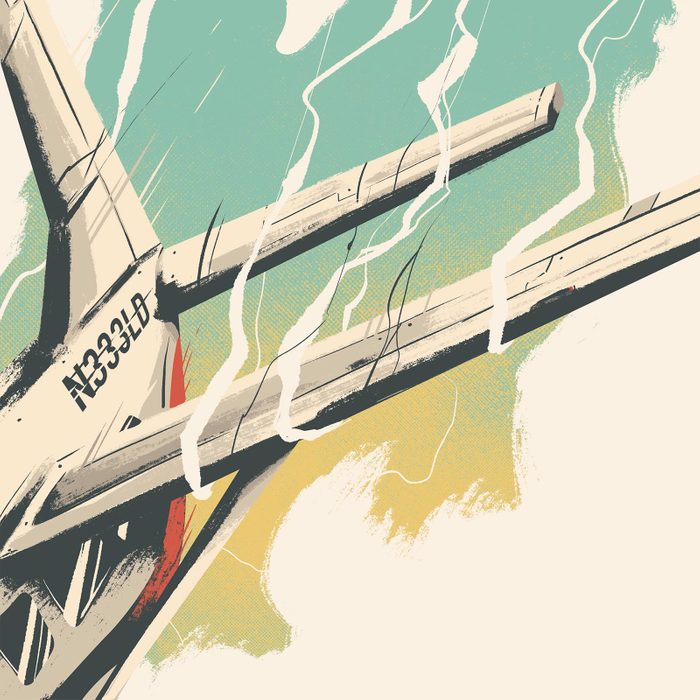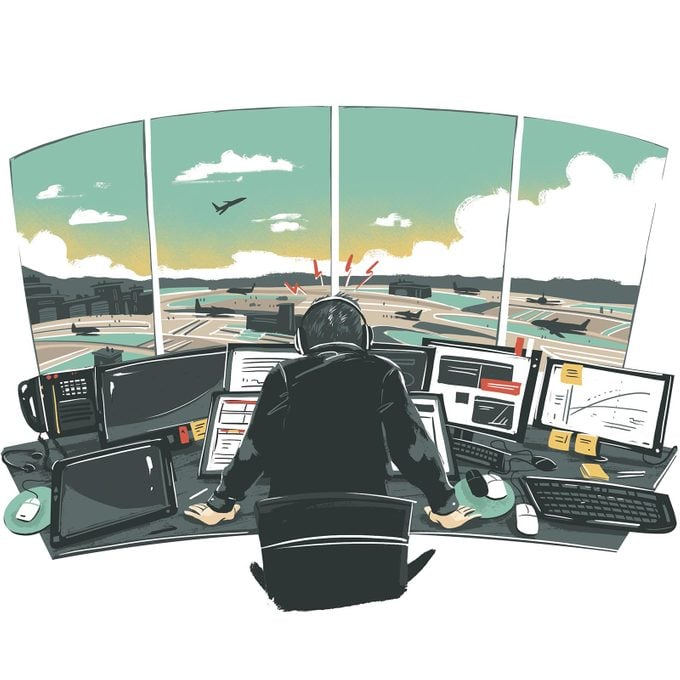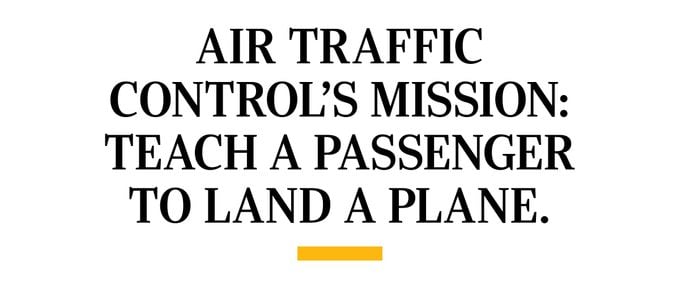This Passenger Got an Emergency Flying Lesson After His Pilot Passed Out at 10,000 Feet
Updated: Nov. 17, 2022

The plane is careening toward the sea without a pilot. Air traffic control’s mission: Teach a passenger to land a plane.
The selfie Darren Harrison has just taken shows him dressed casually in white shorts and a T-shirt with his bare feet propped up on a plush gray leather seat. He is the lone passenger in the roomy six-seat cabin of a single-engine Cessna 208 turboprop some 12,000 feet above the Atlantic off the east coast of Florida.
He sends the photo to his wife, Brittney Harrison, who is six months pregnant with their first child. Harrison, a 39-year-old flooring sales executive, is returning to his home in Lakeland, Florida, after taking part in an offshore deep-sea-fishing tournament in Marsh Harbour, Bahamas.
It’s around noon. The early May weather is perfect, and the views—brilliant blue skies and crystalline ocean below—are drop-dead beautiful. The plane is being flown by Ken Allen, a 64-year-old veteran pilot. To Allen’s right in the co-pilot’s seat is his friend Russ Franck, 70. Franck’s no pilot, but he does enjoy going along for the ride.
Around 45 minutes into their scheduled 75-minute flight to Treasure Coast International Airport in Fort Pierce, Florida, air traffic controllers in Miami clear Allen to begin his approach to Fort Pierce, which is now about 70 miles to the west. They instruct him to descend to 10,000 feet.
“November 333 Lima Delta, Roger, Miami Center,” says Allen, using the plane’s call sign.
A few minutes later, as Allen continues his descent, the right side of his head starts pounding: Boom! Boom! Boom! Every time his heart beats, Allen feels as if his head is being hit with a hammer.
What the heck? Allen wonders as he winces in pain. Out of his right eye, he begins seeing bright blue lights flashing.

“Guys, I don’t feel good,” he tells Harrison and Franck. The pain is severe. The pounding intensifies. His voice shaking, he says, “Everything is fuzzy!” It’s one of the scariest possible moments as a pilot.
Harrison answers immediately, “What does that mean?”
“I don’t know. My head is killing me! I don’t …” Allen suddenly stops talking, and Harrison watches him slump back in his seat. The plane is now careening toward the sea without a pilot.

Harrison manages to undo his seat belt and, fighting G-forces that want to pin him back to his seat, stumbles a few feet to Allen. He and Franck try to rouse Allen. No response. The pilot is unconscious. And the plane is out of control, plummeting in a deep, dizzying 340-mile-per-hour dive to the ocean below.
Instead of blue sky, the two men see whitecaps on waves below that are getting bigger and bigger as the plane continues to drop to 9,000, then 8,000, then 7,000 feet. The Cessna Caravan’s automatic emergency alarms are wailing. Although he’s never taken a flying lesson, Harrison has flown on enough small planes and observed enough pilots to know that he has to pull back on the plane’s yoke to bring the plane’s nose up. But he has to do it slowly: It’s an unfortunate airplane feature that if you pull the yoke too quickly, the motor could stall or the wings could be ripped off. Squatting behind Allen’s seat, he reaches over the unconscious pilot and grabs the yoke while Franck grabs the co-pilot’s yoke.
As the plane falls, both Harrison and Franck struggle to level off the plane, which has dropped nearly 4,000 feet in 30 seconds. Soon, the plane’s nose levels off and turns up, before climbing back to 9,000 feet.
“Can you hold this steady?” Harrison asks Franck. While holding the co-pilot’s yoke, Franck helps Harrison unbuckle Allen’s seat belt, and Harrison pulls him off the seat and gently lays the unconscious pilot on the floor of the cabin. Harrison quickly climbs into the pilot’s seat and takes stock of the situation. First and foremost, they are alive. But they are a long way from home. And neither man has ever flown a plane before.

A serious situation
Air traffic controller Chip Flores has been on duty in the control tower at Fort Pierce’s Treasure Coast International Airport since 7 a.m. Because the winds have recently picked up, many of the student pilots who would normally be flying have been grounded, and Flores is thankful for the low traffic.
The quiet is interrupted when Flores gets a call on his headset. It’s Harrison: “Traffic. N Triple 3, Lima Delta. Come in,” he says, using the plane’s call sign the way he’d heard Allen say it.
Flores responds, “Caravan 333, Lima Delta, Fort Pierce tower.”
“I’ve got a serious situation here,” says Harrison. “My pilot … uh … has gone … incoherent. I have no idea how to fly the airplane.”
Flores jumps from his seat and hits a button on his console that broadcasts the radio transmission through the control tower’s loudspeakers. Alerted to an emergency, everyone in the tower drops what they are doing and listens to the call.

Flores asks Harrison, “What’s your position?”
“I have no idea. I see the coast of Florida in front of me, and I have no idea.”
Flores takes a deep breath. What he doesn’t know is that somehow the Cessna’s display screens have gone blank. Harrison must have hit a switch that turned them off when he tugged Allen from his seat. The only instruments that are still operational are the altimeter, a basic compass, and the attitude indicator, which shows whether the plane is level.
What Flores does know is that he may lose radio contact with Harrison at any minute because the plane is flying south and will soon be beyond the airport’s radio transmission limits. Flores is also concerned about those first words Harrison said: “I have no idea how to fly the airplane.”
Harrison, Flores decides, needs a quick flying lesson. He radios Harrison and calmly tells him, “Try to hold the wings level, and see if you can start descending for me. Push forward on the controls, and descend at a very slow rate.”
Flores and the entire tower team await Harrison’s response.
“Yeah, we are descending right now at 550 feet a minute. … What heading do I need to be at?”
Flores never gets the chance to tell him. He’s lost contact with the plane as it flies out of the airport’s radio transmission zone.
Flores radios Harrison, “This is Fort Pierce tower. Are you on the frequency?”
No answer.
Inside November 333 Lima Delta, Harrison and Franck realize they have lost contact with the tower. Flores’s voice is replaced by static, then nothing. Once again, Harrison and Franck are on their own. While Harrison holds the plane steady, Franck tries to figure out where they are. And if they are even flying in the right direction. Franck had ceded control of the plane to the younger Harrison under the mistaken belief that he may have had some flight simulator experience because he seemed so focused.

Franck peers out his window and says, “Look, there’s the coast over there.” He checks his compass to double-check his bearings. “We need to go west to get to the airport.”
Harrison nods and makes a gradual turn toward the coast.
Franck instinctively reaches down to where Ken Allen is lying on the floor and taps his feet. The stricken pilot moves ever so slightly, and Franck whispers, “Hang in there, Ken. Hang in there, my friend.”
A high-stakes mission
As the plane flies into Palm Beach International Airport airspace, air traffic controllers there take over from Flores. Their main mission: Find someone to teach a passenger who has never flown before how to land a plane.
Greg Battani, air traffic control specialist at the Palm Beach airport, pages Robert Morgan, who is sitting outside and reading a book on his break. Morgan, an experienced air traffic controller and flight instructor, hears the page: “Morgan! Come to the radar room immediately.” He slips on his shoes and rushes inside.

The airport’s operations manager, Mark Siviglia, meets him at the door and quickly briefs him: “We have passengers flying a plane, a Cessna 208. The pilot is unconscious. Can you help land this plane?”
Morgan’s eyes widen, and he thinks, Is this really happening? This sounds like a movie!
Morgan sits down at a radar scope in the darkened radar room and thinks, What am I going to tell this guy? Gathering his nerves, he radios Harrison, who is now about 20 miles to the south and flying west toward the Florida coastline. “This is 322 Palm Beach approach. What we are going to do is get you to Boca Raton airport.”
Harrison responds, “I am not a pilot. My screens are black.”
“No problem. I want you to make a shallow turn to the north and hold steady at 3,000 feet.”
Morgan and the other controllers follow the Cessna on their radar screens as it turns slightly to the north on a heading for the airport at Boca Raton. Morgan radios Harrison, “That’s great. You look good.” Then, because he knows it’s important to keep in radio contact with a trainee pilot, he adds reassuringly, “Don’t worry. I’m here for you.”
Standard practice in an aviation emergency is to get the plane on the ground as soon as possible. In this case, that would mean landing at the Boca Raton airport. But Boca Raton is a congested area, and the airport has only one runway. So Morgan decides to reroute Harrison farther north to the larger Palm Beach International Airport with its three massive 10,000-foot-long runways and a host of emergency services.
“Maintain your height at 3,000, and start a shallow turn to the right.” Shallow turns are key. Too steep a turn by an untrained flier could cause the plane to spiral to the ground.
As soon as Morgan radios the change, the Palm Beach International Airport staffers swing into action. Air traffic controllers man the radios, stop all departures at the busy airport and place incoming flights into holding patterns. Emergency responders are ordered into positions along the runway, and all vehicles and planes are moved away from the airport’s three runways.
Harrison and Franck are glued to their headsets, listening to Morgan’s instructions. Franck scans the ground for familiar landmarks. He sees the I-95 freeway and nudges Harrison. They follow it north to Palm Beach International Airport.
As they do so, Harrison practices controlling the Cessna’s altitude, pushing the yoke forward to descend a bit and pulling it back to go up again. He also makes some small turns to the right, then to the left.
The plane is now about 6 miles south of the Palm Beach airport. “You should see the airport straight ahead,” Morgan tells Harrison. “I want you to start descending to 2,000 feet.”
“That guy is amazing”
As Harrison descends, Morgan grows concerned that Harrison is still flying too fast for a safe landing. He’s also worried about 28 mph crosswinds swirling around the runway, which can easily force a small plane off course on landing. Morgan tells him to make a slight turn to the west.
“We’re going to bring you out to the west and give you more time to get lower and perfectly lined up with the runway,” he says.
Harrison follows each of Morgan’s instructions and is now turning the plane back to the airport to make his approach to the massive Runway 10L.
“Let’s slow you down,” says Morgan. “See that black throttle control in front of you? Pull that back a little bit. Keep your speed above 110 knots.”

Harrison throttles back and lines up the runway, which is 3 miles away. The radar room is quiet; everyone’s eyes are glued to the radar screens, watching this final approach.
“Your speed looks fine,” Morgan tells Harrison. “As you get closer, the runway will get wider, and once it gets really wide, I want you to pull the power back to you and also pull back on the controls.”
“Hey! I don’t know how to use the brakes. What do I do when I land?”
“When you get to the ground, just put your feet on the top of the pedals and apply a bit of pressure.” Morgan quickly adds, “Gentle! Be very gentle when you press on the pedals.” What he doesn’t mention is that putting too much pressure on the brakes too early can blow a tire, causing a pilot to lose control of the plane, possibly crashing on the runway.
As the Cessna nears the airport, Morgan reads out the plane’s altitude to Harrison, “600 feet … 500 feet … 400 feet. … You’re doing great!”
Harrison, now 1 mile from landing, descends to 300 feet and is on target to land on Runway 10L. The airport’s radar cannot pick up planes under 300 feet, and November 333 Lima Delta disappears from Morgan’s screen.
“Are you still there?” Morgan shouts.
Ten seconds of torturous silence follow. Morgan swallows deeply as he and the other controllers in the blacked-out radar room stare at the blank radar screens.

Three seconds … four seconds … five seconds … six seconds. … Nothing. Seven seconds … eight seconds … nine seconds …
Then the room’s loudspeaker crackles to life. It’s Harrison. “I’m on the ground. How do I stop this thing?”
Morgan hits the radio call button: “Use the toe brakes—gently!”
Harrison, still barefoot, presses the tops of the pedals gently and brings the plane to a stop, smack-dab in the middle of the runway, 25 minutes after taking the controls.
The radar room erupts in cheers. Exhausted but flushed with adrenaline, Morgan stands and blinks back tears.
Harrison, feeling comfortable at the plane’s controls, radios Morgan, “Hey, do you want me to taxi this off the runway?”
Morgan chuckles. “Amazing,” he says to himself. “That guy is amazing.”
Editor’s note: Ambulances rushed Ken Allen to the nearby Palm Beach Gardens Medical Center, where he was diagnosed with an aortic dissection, a tear in the inner layer of the aorta that is often fatal. Doctors operated immediately, and he is expected to make a full recovery.
Next, learn the reasons behind airplane safety rules and why some airplane seats face backward.















